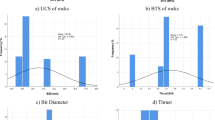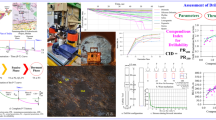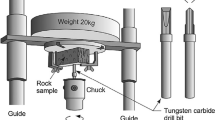Abstract
Rock drilling Penetration Rate (PR) is influenced by many parameters including rock properties, machine parameters of the chosen rig and the working process. Five datasets were utilized to quantitatively assess the effect of various rock properties on PR. The datasets consisted of two sets of diamond and percussive drilling and one set of rotary drilling data. A new rating system called Rock Drillability Characterization index (RDCi) is proposed to predict PR for different drilling methods. This drillability model incorporates the uniaxial compressive strength of intact rock, the P-wave velocity and the density of rock. The RDCi system is further applied to predict PR in the diamond rotary drilling, non-coring rotary drilling and percussive drilling. Strong correlations between PR and RDCi values were observed indicating that the developed drillability rating model is relevant and can be utilized to effectively predict the rock drillability in any operating environment. A practical procedure for predicting PR using the RDCi was established. The drilling engineers can follow this procedure to use RDCi as an effective method to estimate drillability.





Similar content being viewed by others
References
S. Akin, C. Karpuz, Estimating drilling parameters for diamond bit drilling operations using artificial neural networks. Int. J. Geomech. 8, SPECIAL ISSUE: Excavation Geomechanics for Energy, Environmental, and Transportation Infrastructure, 68–73 (2008)
A. Bhatnagar, M. Khandelwal, An intelligent approach to evaluate drilling performance. Neural Comput. Appl. 21, 763–770 (2012)
S. Kahraman, N. Bilgin, C. Feridunoglu, Dominant rock properties affecting the penetration rate of percussive drills. Int. J. Rock Mech. Min. Sci. 40(5), 711–723 (2003)
M.M. Protodyakonov, Mechanical properties and drillability of rocks, in Proceedings of the 5th Symposium Rock Mechanics, pp. 103–118, University of Minnesota (1963)
J. Paone, D. Madson, W.E. Bruce, Drillability studies—laboratory percussive drilling. US Bureau of Mines RI 7300 (1969)
S. Tandanand, H.F. Unger, Drillability determination—a drillability index of percussive drills. US Bureau of Mines RI 8073 (1975)
A.G. Pathankar, G.B. Misra, A critical appraisal of the Protodyakonov Index. Int. J. Rock Mech. Min. Sci. 13(8), 249–251 (1976)
H. Rabia, Oilwell Drilling Engineering: Principles and Practise (Graham & Tromtman, Huddersfield, 1985)
D.F. Bond, The optimization of PDC bit selection using sonic velocity profiles present in the Timor Sea. SPEDE 5, 135–142 (1990)
V.P. Perrin, M.G. Wilmot, W.L. Alexander, Drilling Index—a new approach to bit performance evaluation. in SPE/IADC Drilling Conference, Paper SPE 37595 (Amsterdam, The Netherlands, 1977), pp. 199–205
A.A. Selim, W.E. Bruce, Prediction of penetration rate for percussive drilling. USBM RI 7396 (1970)
D.P. Singh, A study of some aspects of drag-bit drilling. Met. Min. Rev. 5(15), 1–4 (1976)
A.G. Pathankar, G.B. Misra, Drillability of rocks in percussive drilling from ‘energy per unit volume’ as determined with a microbit. Min. Eng. 32, 1407–1410 (1980)
G.B. Clark, Principles of rock drilling part-1, Colorado School of Mines. Quarterly 1(77), 118 (1982)
D.F. Howarth, J.C. Rowland, Quantitative assessment of rock texture and correlation with drillability and strength properties. Rock Mech. Rock Eng. 20, 57–85 (1987)
A. Ersoy, M.D. Walker, Prediction of drill bit performance using multivariate linear regression analysis. Trans. Inst. Min. Metall. 104, 70–94 (1995)
K. Thuro, G. Spaun, Introducing the ‘destruction work’ as a new rock property of toughness referring to drillability in conventional drill and blast tunnelling. in Proceeding of Eurock’96 (Turin, Italy, 1996), pp. 707–713
S. Kahraman, Rotary and percussive drilling prediction using regression analysis. Int. J. Rock Mech. Min. Sci. 36(7), 981–989 (1999)
G.M. Wilmot, B. Calhoun, V.P. Perrin, Formation drillability—definition, quantification, and contribution to bit performance evaluation. in SPE/IADC Middle East Drilling Technology Conference, Abu Dhabi, UAE, Paper SPE 57558 (1999)
S.H. Hoseinie, M. Atael, M. Osanloo, A new classification system for evaluating rock penetrability. Int. J. Rock Mech. Min. Sci. 46(8), 1329–1340 (2009)
T. Olgay, K. Sair, The drillability assessment of rocks using the different brittleness values. Tunn. Undergr. Space Technol. 26, 406–414 (2011)
N. Bilim, Determination of drillability of some natural stones and their association with rock properties. Sci. Res. Essays 6, 382–387 (2011)
L. Wilbur, Rock Tunnels, in Tunnel Engineering Handbook, ed. by J.O. Bichel, T.R. Kuesel (Van Nostrand Reinhold Company, New York, 1982)
D.F. Howarth, Experimental study on the relationship between rock texture and mechanical performance. Trans. Inst. Min. Metall. Sect. A 95, 41–45 (1986)
S.H. Hoseinie, H. Aghababaei, Y. Pourrahimian, Development of a new classification system for assessing of Rock mass Drillability index (RDi). Int. J. Rock Mech. Min. Sci. 45(1), 1–10 (2008)
S. Kumar, V.M.S.R. Murthy, Experimental studies on drill penetration rate prediction in coal measure rocks through Cerchar hardness index tests. J. Mines Metals Fuels 62(4), 88–95 (2014)
S. Kumar, V.M.S.R. Murthy, Predicting penetration rate for rotary blast hole drills in surface coal mines—an approach. in 6th National Seminar on Surface Mining (NSSM), Indian School of Mines, Dhanbad, 10–11 January (2014)
H. Rabia, N. Brook, An empirical equation for drill performance prediction, in Proceeding of 21st Symposium in Rock Mechanics, pp. 103–111 (1980)
H. Rabia, N. Brook, The effects of apparatus size and surface area of charging on the impact strength of rock. Int. J. Rock Mech. Min. Sci. 18, 211–220 (1981)
Norwegian Institute of Technology, Drillability, drilling rate index catalogue. PR 8-79 (Norwegian Institute of Technology, Trondheim, 1981)
R. Selmer-Olsen, O.T. Blindheim, On the drillability of rock by percussive drilling. in Proceedings of the Second Congress International Society on Rock Mechanics (1970), pp. 65–70
R.L. Schmidt, Drillability studies—percussive drilling in the field. USBM RI 7684 (1972)
M. Heinio, Rock excavation handbook (Sandvik Tamrock Corp, Stockholm, 1994)
R.J. Fowell, I. Mcfeat-Smith, Factors influencing the cutting performance of a selective tunnelling machine. in ed. by J.M. Jones. Proceedings of the First International Symposium on Tunnelling’76 (IMM, London, 1976)
S. Eskikaya, N. Bilgin, T. Dincer, A model to predict the cutting performance of rapid excavation systems. in ed. R.K. Singhal. Proceedings of the Seventh International Symposium on Mine Plan Equipment Selection, Calgary (1998), pp. 575–9
A. Cheniany, K.S. Hasan, K. Shahriar, H.J. Khademi, An estimation of the penetration rate of rotary drills using the specific rock mass drillability index. Int. J. Min. Sci. Technol. 22(2), 187–193 (2012)
W.A. Hustrulid, C. Fairhurst, A theoretical and experimental study of the percussive drilling of rock. Part I: theory of percussive drilling. Int. J. Rock Mech. Min. Sci. 8, 35–56 (1971)
K. Thuro, Prediction of drillability in hard rock tunnelling by drilling and blasting, in Proc. ITA Congress Tunnels for People, ed. by J. Golser, W.J. Hinkel, W. Schubert (Vienna, Balkema, Rotterdam, 1997), pp. 103–108
M.E. Akun, C. Karpuz, Drillability studies of surface-set diamond drilling in Zonguldak region sandstones from Turkey. Int. J. Rock Mech. Min. Sci. 42(3), 473–479 (2006)
N. Bilgin, S. Eskikaya, T. Dincer, The performance analysis of large diameter blast hole rotary drilling in Turkish Coal Enterprises, in Mine Mechanization and Automation, ed. by G. Almgren, U. Kumar, N. Vagenas (Balkema, Rotterdam, 1993)
A. Ersoy, Automatic drilling control based on minimum drilling specific energy using PDC and WC bits. Min. Technol. 112(2), 86–96 (2003)
K.O. Hakalehto, Energy required to break rock by percussive drilling. in Proceedings of the 14th Symposium in Rock Mechanics, Pennsylvania State University (1972), pp. 613–621
D.F. Howarth, W.R. Adamson, J.R. Berdt, Correlation of model tunnel boring and drilling machine performance with rock properties. Int. J. Rock Mech. Min. Sci. 23(2), 171–175 (1986)
L.E. Izquierdo, L.E. Chiang, A methodology for estimation of the specific rock energy index using corrected down-the-hole drill monitoring data. Trans. Inst. Min. Metall. Sect. 113, A225–A236 (2004)
S. Kahraman, C. Balci, S. Yazici, N. Bilgin, Prediction of the penetration rate of rotary blast hole drilling using a new drillability index. Int. J. Rock Mech. Min. Sci. 37, 729–743 (2000)
X. Li, G. Rupert, D.A. Summers, P. Santi, D. Liu, Analysis of impact hammer rebound to estimate rock drillability. Rock Mech. Rock Eng. 33(1), 1–13 (2000)
W.C. Maurer, The State of Rock Mechanics Knowledge in Drilling. in Proceedings of the Eighth Symposium on Rock Mechanics, University of Minesota (1966), pp. 355–95
R.J. Plinninger, G. Spaun, K. Thuro, Prediction and classification tool wear in drill and blast tunnelling. in Proceedings of the 9th congress international association for engineering geology and the environment (Durban, South Africa, 2002), pp. 16–20
K.U.M. Rao, A. Bhatnagar, A. Misra, Laboratory investigations on rotary diamond drilling. Geotech. Geol. Eng. 20(1), 1–16 (2002)
N. Schormair, K. Thuro, R. Plinninger, The influence of anisotropy on hard rock drilling and cutting. in Proceedings of the IAEG, Geological Society of London. Paper number: 491 (2006)
T. Serradj, Method of assessment of rock drillability incorporating the Protodyakonov index. Trans. Inst. Min. Metall. Sect. A 105, 175–179 (1996)
H. Shimada, K. Matsui, Estimation of applicability of a drilling machine in Japanese open pit limestone quarry. in Proceedings of the Forth International Symposium on Mine Planning and Equipment Selection, Canada (1995), pp. 523–528
R. Simon, Theory of rock drilling. in Proceedings of the sixth annual drilling symposium (University of Minnesota, 1956) pp. 1–14
T.N. Singh, A.R. Gupta, R. Sain, A comparative analysis of cognitive system for the prediction of drillability of rocks and wear factor. Geotech. Geol. Eng. 24(2), 299–312 (2006)
A.S. Tanaino, Rock classification by drillability. Part 1: analysis of the available classification. J. Min. Sci. 41(6), 541–549 (2005)
A.S. Tanaino, A.A. Lipin, State and prospects of the percussive-rotary blasthole drilling in quarries. J. Min. Sci. 40(2), 188–198 (2004)
Author information
Authors and Affiliations
Corresponding author
Rights and permissions
About this article
Cite this article
Taheri, A., Qao, Q. & Chanda, E. Drilling Penetration Rate Estimation using Rock Drillability Characterization Index. J. Inst. Eng. India Ser. D 97, 159–170 (2016). https://doi.org/10.1007/s40033-015-0104-6
Received:
Accepted:
Published:
Issue Date:
DOI: https://doi.org/10.1007/s40033-015-0104-6




